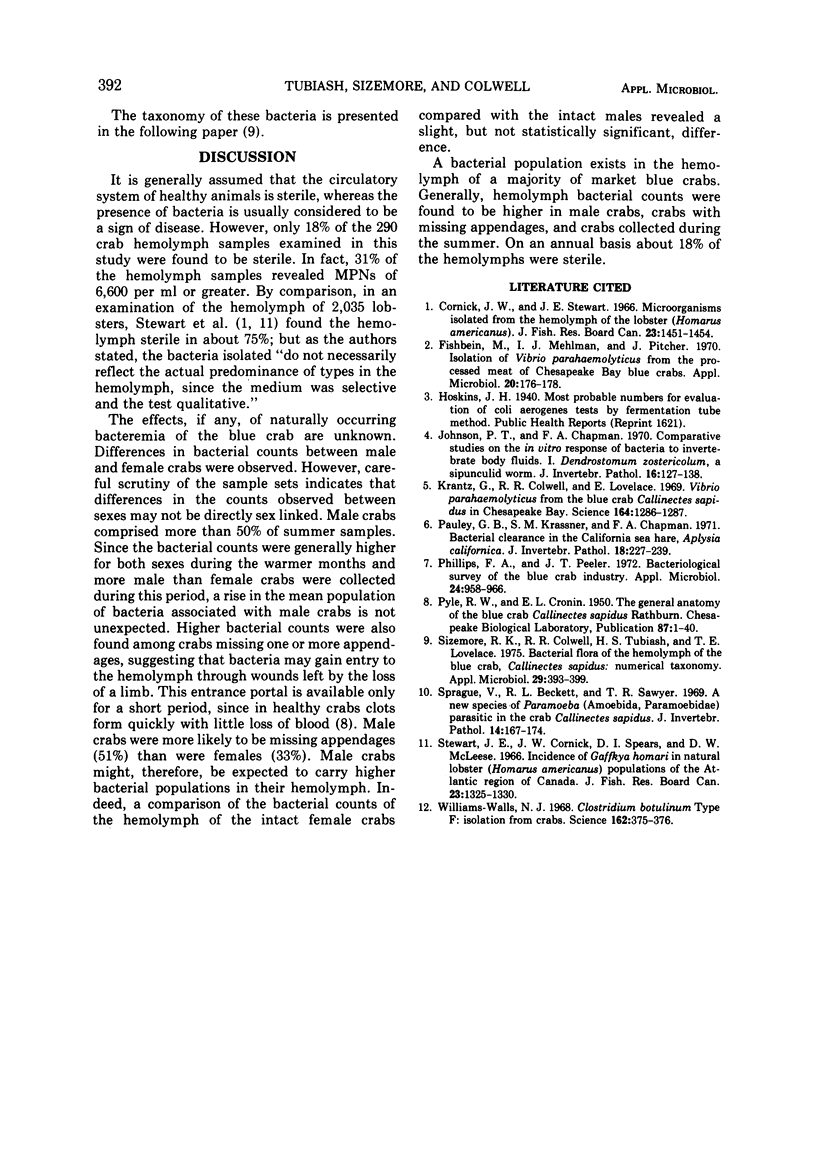Abstract
The hemolymph of 290 freshly collected blue crabs from Chincoteague Bay, Va., was sampled over a 15-month period from August 1968 through November 1969 and most probable numbers of bacteria were determined by tube dilution. The hemolymph of 18% of all crabs sampled was found to be sterile, with 16% sterility in summer and 23% in winter samples. Despite individual variations, male crabs as a group had a higher bacterial hemolymph burden than females, and among both sexes summer counts were higher than winter. The hemolymph of crabs with missing appendages had significantly higher counts than uninjured crabs. The annual mean hemolymph most probable numbers per ml was 2,756 for males, 1,300 for females, and 1,876 for both sexes. The higher bacterial levels found in the hemolymph of male crabs may, in part, be explained by the fact that males, which predominated in the summer samples, had a higher incidence of injury and missing appendages than did females.
Full text
PDF




Images in this article
Selected References
These references are in PubMed. This may not be the complete list of references from this article.
- Fishbein M., Mehlman I. J., Pitcher J. Isolation of Vibrio parahaemolyticus from the processed meat of Chesapeake Bay blue crabs. Appl Microbiol. 1970 Aug;20(2):176–178. doi: 10.1128/am.20.2.176-178.1970. [DOI] [PMC free article] [PubMed] [Google Scholar]
- Johnson P. T., Chapman F. A. Comparative studies on the in vitro response of bacteria to invertebrate body fluids. I. Dendrostomum zostericolum, a sipunculid worm. J Invertebr Pathol. 1970 Jul;16(1):127–138. doi: 10.1016/0022-2011(70)90218-1. [DOI] [PubMed] [Google Scholar]
- Krantz G. E., Colwell R. R., Lovelace E. Vibrio parahaemolyticus from the blue crab Callinectes sapidus in Chesapeake Bay. Science. 1969 Jun 13;164(3885):1286–1287. doi: 10.1126/science.164.3885.1286. [DOI] [PubMed] [Google Scholar]
- Pauley G. B., Krassner S. M., Chapman F. A. Bacterial clearance in the California sea hare, Aplysia californica. J Invertebr Pathol. 1971 Sep;18(2):227–239. doi: 10.1016/0022-2011(71)90150-9. [DOI] [PubMed] [Google Scholar]
- Phillips F. A., Peeler J. T. Bacteriological survey of the blue crab industry. Appl Microbiol. 1972 Dec;24(6):958–966. doi: 10.1128/am.24.6.958-966.1972. [DOI] [PMC free article] [PubMed] [Google Scholar]
- Sizemore R. K., Colwell R. R., Tubiash H. S., Lovelace T. E. Bacterial flora of the hemolymph of the blue crab, Callinectes sapidus: numerical taxonomy. Appl Microbiol. 1975 Mar;29(3):393–399. doi: 10.1128/am.29.3.393-399.1975. [DOI] [PMC free article] [PubMed] [Google Scholar]
- Williams-Walls N. J. Clostridium botulinum Type F: Isolation from Crabs. Science. 1968 Oct 18;162(3851):375–376. doi: 10.1126/science.162.3851.375. [DOI] [PubMed] [Google Scholar]



